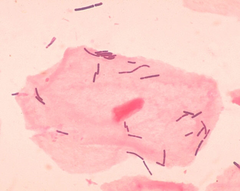Lactobaccillus
Lactobacillus is a genus of Gram-positive, facultative anaerobic or microaerophilic, rod-shaped, non-spore-forming bacteria. They are a major part of the lactic acid bacteria group (i.e. they convert sugars to lactic acid). In humans, they constitute a significant component of the microbiota at a number of body sites, such as the digestive system, urinary system, and genital system. In women of European ancestry, Lactobacillus species are normally a major part of the vaginal microbiota.Lactobacillus forms biofilms in the vaginal and gut microbiota, allowing them to persist during harsh environmental conditions and maintain ample populations.Lactobacillus exhibits a commensal relationship with the human body as it protects the host against potential invasions by pathogens, and in turn, the host provides a source of nutrients.Lactobacillus is the most common probiotic found in food such as yogurt, and it is diverse in its application to maintain human well-being as it can help treat diarrhea, vaginal infections and skin disorders such as eczema.
Many lactobacilli operate using homofermentative metabolism (they produce only lactic acid from sugars), and some species use heterofermentative metabolism (they can produce either alcohol or lactic acid from sugars). They are aerotolerant despite the complete absence of a respiratory chain. This aerotolerance is manganese-dependent and has been explored (and explained) in Lactobacillus plantarum. Many species of this genus do not require iron for growth and have an extremely high hydrogen peroxide tolerance.
...
Wikipedia

